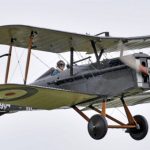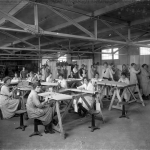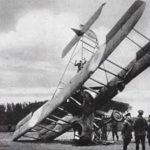H.H. Martin was a Cheltenham based company that originally specialised in architectural decoration. During the First World War, the company developed; and in early 1918 the Gloucestershire aircraft company was formed. Thus beginning the thriving aviation industry in Cheltenham.
By April 1918, approximately 45 aircraft were being made in Cheltenham every week. Much of this productivity was due to the hard work of local women who were called upon to fill the gaps on the workforce.
With many of the male workers absent and serving with the armed forces, women were employed for the first time to build aircraft and took over roles previously performed only by men prior to the war. For many this meant they had money of their own to spend, perhaps for the first time.
Sir ‘Dusty’ Miller of the Royal Air Force Association believes that the First World War still affects the people of Cheltenham today.
“Regardless of your age, there’s a high probability that a member of your family was effected by the First World war. The war changed Cheltenham and the surrounding region forever.”
The summer of 1918 saw several hundred flight cadets come to Cheltenham to begin their training. They took over part of Cheltenham Town Hall and were assigned to houses around the town The Cadets were very popular and were supported by the newly created Women’s Royal Air Force (WRAF), who were locally employed to serve in the Cheltenham area, other women worked as flight mechanics.
According to Tony Mason exhibition co-ordinator for the Cheltenham Branch of the Royal Air Force Association; “the men may have been away fighting, while the women could’ve been working in the local aircraft factory, or making bombs and shells in a munitions factory.”
The end of the war saw the flight cadets based in Cheltenham join the factory workers in order to celebrate. Guns were fired into the air and those celebrating paraded around the town, victorious.
The women of Cheltenham celebrated the return of their sweethearts, husbands, brothers and fathers as they were gradually demobalised and allowed to return home. Sadly, around 1,600 men from Cheltenham never made this journey home. Many are commemorated on war memorials around the town and their sacrifice is remembered each November.
Not only was Cheltenham renowned for the creation of aircraft, the town was also involved with the development of a new form of information interception. British Army units found a way to intercept the Morse code messages sent between German soldiers.
The top secret advances in this form of intelligence gathering provided the troops with the information needed to win the War. Since then, the successors of the communications unit that intercepted these messages have continued to work closely with the RAF, and we now know them as the Government Communications Head Quarters or GCHQ.
Since the birth of the Royal Air Force 100 years ago they have worked closely with intelligence services like GCHQ and continue to do so today.
After the war ended the RAF flight cadets moved away and members of the WRAF (Women’s Royal Air Force) returned to civilian life. However, the Gloucester Aircraft Company survived post-war reductions, and over the years, other household names within the aviation industry became associated with the town; especially Dowty Aviation and its successors, including the company SAFRAN.
The ‘Great War’ was the catalyst for the development of the aviation industry in Cheltenham and it transformed the town both socially and economically from a sleepy 19th century retirement town, into a thriving town ready to meet the challenges of the new century.
By Claudia Dunn (Student at the University of Gloucestershire)




Leave a Reply